Understanding the Fundamentals of Marine Navigation and Cross-Referencing Maintenance Techniques
Effective navigation at sea is the backbone of maritime safety and successful voyage planning. Whether you are sailing a small boat or operating a large vessel, a comprehensive understanding of navigation principles and the proper maintenance of your navigational equipment are essential. This guide delves into the core concepts of marine navigation, particularly focusing on the concept of Boots Versegelung, and emphasizes the importance of keeping your navigation tools in pristine condition to ensure accurate and reliable information throughout your journey.
1. Fundamentals of Marine Navigation
1.1 What is Marine Navigation?
Marine navigation involves determining a vessel’s position and plotting its course to reach a destination safely. This involves an array of tools and techniques, including traditional methods like celestial navigation and modern electronic systems such as GPS. Central to effective navigation is understanding how to interpret various navigational cues, including landmarks, magnetic compasses, and, increasingly, digital aids. A crucial aspect often overlooked is the significance of Versegelung, which pertains to the alignment or setting of the sails or rigging in traditional sailing, but in modern terms relates to the precise configuration and orientation necessary for optimal control and safety.
1.2 Importance of Accurate Navigation for Safety at Sea
Accurate navigation prevents collisions, groundings, and other accidents. It enables mariners to stay on course, especially in challenging conditions such as fog, night, or adverse weather. A navigator must constantly cross-verify position estimates, update charts, and ensure that all instruments are functioning properly. For example, the process of versegelungspeilung, which is part of terrestrial navigation, involves estimating relative positions based on known landmarks or celestial objects. This technique remains relevant as a backup or complementary method to electronic systems.
1.3 Key Navigational Instruments
Modern vessels rely on GPS, radar, depth sounders, and electronic chart systems. However, traditional tools such as compasses, sextants, and nautical charts are still invaluable, especially when electronic systems fail. For example, the compass provides a reliable heading reference, while the sextant allows celestial navigation even without electronic aids. Maintaining these instruments, including cleaning, calibration, and proper storage, is crucial—attributes that emphasize the need for routine Boats Maintenance.
2. Maintenance and Care of Navigational Equipment
2.1 Regular Inspection and Calibration
Consistent maintenance ensures that navigational tools provide accurate readings. Magnetic compasses should be checked against known references and calibrated periodically to compensate for deviations caused by nearby magnetic fields. Likewise, electronic instruments require software updates and physical inspections to prevent malfunctions. A neglected device can lead to miscalculations, jeopardizing the safety of the boat and crew.
2.2 Selecting the Right Navigation Tools
Choice of instruments depends on the vessel type, voyage length, and operating environment. For small boats, handheld compasses and paper charts might suffice, while larger ships benefit from integrated electronic navigation systems. However, even high-tech devices should be complemented with traditional backups to ensure resilience. Proper care—like cleaning with specialized cloths (e.g., BCC Microfaser Towel)—and safeguarding against corrosion are vital in extending the lifespan of these tools.
2.3 Avoiding Common Errors in Marine Navigation
Errors such as misreading instruments, improper calibration, or neglecting to update charts can cause serious navigational issues. The use of high-quality cleaning and maintenance products helps prevent dirt and corrosion that impair instrument accuracy. Implementing regular equipment check routines and adhering to best practices can significantly reduce the risk of errors, keeping your navigation precise and dependable.
3. Practical Application of Marine Navigation Techniques
3.1 Step-by-Step Navigation Planning
Begin with comprehensive route planning on nautical charts, noting landmarks, hazards, and intended waypoints. Use tools like the BCC Power Cleaner and polishing sets to maintain your equipment beforehand. During sailing, continuously cross-check GPS data with visual cues and compass bearings to verify your position. Regularly perform peilung (bearing) assessments utilizing known features; these practices reinforce safety and confidence on the water.
3.2 Tips for Precise Orientation
Maintain a steady course by regularly calibrating your compass and verifying against visible features. Use the BCC Snow Foam Gun and other cleaning tools to keep instruments clear of dirt and grime, ultimately improving readability. Employ a systematic approach: measure bearings, record data, and compare with chart plotting for accuracy. Training and experience are crucial—consider participating in simulated navigation exercises or consultation with experienced mariners.
3.3 Navigating in Various Weather Conditions
Adverse conditions require reliance on multiple tools and methods. In fog or storms, radar and AIS (Automatic Identification System) become invaluable. When visibility is limited, sounding devices and active obstacle detection help avoid hazards. In such situations, ensuring your navigational equipment is in optimal condition—using products like BCC Power Sealer for protection against moisture—is essential to prevent malfunctions.
4. Challenges and Solutions in Maritime Navigation
4.1 Recognizing Common Errors
Common mistakes include incorrect interpretation of readings, over-reliance on electronic aids, and inadequate preparation. Additionally, equipment neglect or failure can cause costly errors. Regular inspections with specialized maintenance tools, such as the BCC Polierpuck or Polierschwämme for cleaning delicate surfaces, help maintain accuracy by preventing damage and ensuring clear, readable displays.
4.2 Strategies to Overcome Navigation Challenges
Adopting a multi-layered approach, combining traditional navigation techniques with modern systems, offers resilience against failures. Regular updates to electronic charts, routine manual calculations, and backup equipment are critical. When issues arise, troubleshooting steps include recalibrating instruments, checking power supplies, and verifying external conditions.
4.3 Successful Case Studies
Many experienced mariners advocate for maintaining a balance between tech and tradition. For example, during a challenging crossing, a vessel’s crew relied on celestial navigation, manual bearings, and the maintenance of their compasses and sextants—cleaned and calibrated with the right equipment. This comprehensive approach ensured a safe and precise passage despite electronic failures or adverse conditions.
5. Trends and the Future of Marine Navigation
5.1 Emerging Technologies and Innovations
The integration of AI-based navigation systems, real-time data analytics, and satellite communication is revolutionizing maritime navigation. New approaches like augmented reality overlays on nautical charts assist mariners in real-time decision-making, improving safety and efficiency.
5.2 Digital Tools Integration
Modern vessels increasingly incorporate digital navigation aids that synchronize with traditional instruments. Maintaining these high-tech tools involves routine updates, software management, and physical upkeep—highlighting the importance of reliable maintenance products like the BCC Towels Vorteilspack or the BCC Wash-Kit for cleaning sensitive equipment.
5.3 Training and Skill Development
As technology advances, ongoing training in both digital and traditional navigation techniques remains vital. Mariner education programs emphasize hands-on experience with old-school tools and the latest innovations, fostering a comprehensive skill set that ensures navigational safety and proficiency in diverse scenarios.

